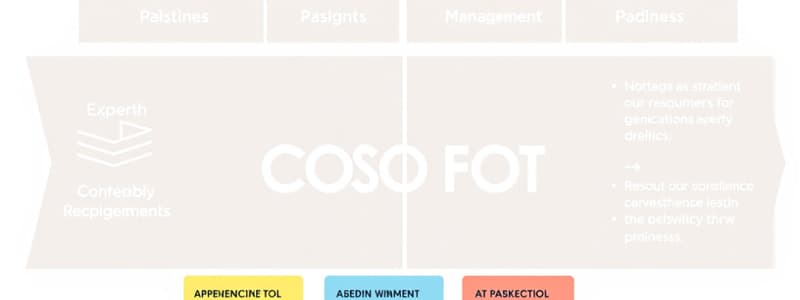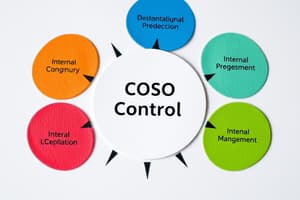Podcast
Questions and Answers
What is the responsibility of management regarding internal control?
What is the responsibility of management regarding internal control?
- Generate unreliable information for decision making
- Neglect internal controls
- Assess control risk (correct)
- Ensure assets and records are safeguarded (correct)
The auditor has no responsibility to obtain an understanding of internal controls.
The auditor has no responsibility to obtain an understanding of internal controls.
False (B)
List the objectives of COSO's Internal Control Integrated Framework.
List the objectives of COSO's Internal Control Integrated Framework.
Reliability of Financial Reporting, Effectiveness and Efficiency of Operations, Compliance with Laws and Regulations.
What does the internal control system aim to safeguard?
What does the internal control system aim to safeguard?
Which of the following is NOT a component of control activities?
Which of the following is NOT a component of control activities?
Match the following components of internal control to their principles:
Match the following components of internal control to their principles:
The audit risk model formula is AR = IR × CR × DR where AR stands for ______.
The audit risk model formula is AR = IR × CR × DR where AR stands for ______.
What strategy may an auditor choose after obtaining an understanding of internal control?
What strategy may an auditor choose after obtaining an understanding of internal control?
Controls that do not pertain to an assertion can lead an auditor to follow a substantive strategy.
Controls that do not pertain to an assertion can lead an auditor to follow a substantive strategy.
What should an auditor understand to plan the audit?
What should an auditor understand to plan the audit?
Which of the following is not one of the five components of internal control?
Which of the following is not one of the five components of internal control?
The auditor may determine if the engagement team needs an ______.
The auditor may determine if the engagement team needs an ______.
What could cause limitations in an entity's internal control?
What could cause limitations in an entity's internal control?
What kind of report goes further by providing assurance on the operating effectiveness of a service organization's controls?
What kind of report goes further by providing assurance on the operating effectiveness of a service organization's controls?
Match the following terms with their definitions:
Match the following terms with their definitions:
The fundamental concepts of internal control are likely to be more formal in small entities than in large entities.
The fundamental concepts of internal control are likely to be more formal in small entities than in large entities.
Study Notes
Internal Control Overview
- Management is responsible for maintaining controls that ensure protection of assets and reliable records.
- Internal control systems must safeguard assets and generate accurate information for decision-making.
- Auditors require assurance on data reliability from the information system.
Auditor's Risk Assessment Procedures
- Understand internal controls and identify key controls.
- Recognize potential misstatement types and design tests of controls and substantive procedures.
- Understanding internal control informs the overall audit strategy and control risk assessment.
COSO’s Internal Control Integrated Framework
- Aims to enhance the reliability of financial reporting, operational effectiveness, and compliance with laws and regulations.
- Emphasizes internal controls relevant to financial statement preparation for audits.
Components of Internal Control
- Control Environment: Establishes organization standards, processes, and structures for internal control.
- Risk Assessment: Ongoing process of identifying and analyzing risks that affect business objectives.
- Control Activities: Actions taken to meet management directives and mitigate risks.
- Information and Communication: Necessary for achieving internal control objectives and maintaining participation.
- Monitoring Activities: Evaluations to check if internal control components function effectively.
Control Environment Principles
- Commitment to integrity and ethical values.
- Board independence and oversight in internal control development.
- Defined structures and responsibilities for objectives.
- Commitment to competent personnel management.
- Accountability for internal control responsibilities.
Risk Assessment Principles
- Clear objectives for risk identification and assessment.
- Identification and analysis of risks affecting business objectives.
- Consideration of fraud potential within risk assessment.
- Ongoing assessment of changes impacting internal controls.
Control Activities Principles
- Selection and development of control activities to mitigate risks effectively.
- General control activities over technology for objective support.
- Deployment of policies and procedures that translate expectations into actions.
Information and Communication Principles
- Generation and use of relevant, quality information for internal control functionality.
- Internal communication of objectives and responsibilities for effective control.
- External communication regarding matters impacting internal controls.
Monitoring of Controls Principles
- Ongoing evaluation of internal control performance quality.
- Timely evaluation and communication of internal control deficiencies.
Audit Strategy
- Audit Risk Model: Represents the relationship among inherent risk, control risk, and detection risk in planning.
- Substantive Strategy: May be adopted when internal control testing is deemed inefficient or ineffective.
- Reliance Strategy: A plan to rely on internal control and to assess control risk at a lower level, based on understanding of the components.
Understanding Internal Control
-
Auditors must grasp each component of internal control to effectively plan their audit approach.### Understanding Internal Control
-
Knowledge helps to identify potential factors affecting the risk of material misstatement.
-
It is essential for designing tests of controls and substantive procedures.
-
An auditor may seek an IT specialist based on the complexity of the entity's IT systems.
Components of Understanding Internal Control
- Grasping the control environment is vital.
- Familiarity with the entity’s risk assessment process is necessary.
- Understanding the information system and communication processes is crucial.
- Control activities and their monitoring must be assessed.
Documenting Internal Control Understanding
- Utilizing procedures manuals and organizational charts enhances documentation.
- Internal control questionnaires serve as a formal method for capturing understanding.
- Flowcharts can visually represent internal controls effectively.
Impact of Entity Size on Internal Control
- Basic components of internal controls apply universally, but formality may vary by entity size.
- Small to midsize entities often exhibit less formal internal controls compared to large entities.
Limitations of Internal Control
- Management can override internal controls.
- Human errors or mistakes remain a significant risk factor.
- Collusion between employees can undermine control effectiveness.
Assessing Control Risk
- Identifying specific controls that will be relied upon is essential for control assessments.
- Tests of controls are necessary to gauge the effectiveness of those controls.
- Auditors must conclude on the achieved level of control risk after testing.
Performing Tests of Controls
- Inspection of documents indicates control performance.
- Inquiry with appropriate personnel can help verify control processes.
- Observational audits review the application of controls.
- Reperformance by the auditor provides assurance of control execution.
Documenting Control Risk Assessment
- Auditors document their control risk assessment using structured working papers.
- Internal control questionnaires and memorandums can provide additional documentation.
Substantive Procedures and Timing
- Procedures conducted at interim periods or year-end help in risk assessments.
- The nature of transactions, control effectiveness, and risks of misstatement guide the timing of audit procedures.
Auditing Service Organizations
- Entities may have accounting transactions processed by service organizations, affecting the audit approach.
- Auditor concerns typically center around the efficacy of the service organization's internal controls.
Types of Reports from Service Organizations
- Type 1 Report: Describes the design of the service organization's controls and their suitability.
- Type 2 Report: Offers assurance on the operating effectiveness of those controls, based on auditor testing.
Communicating Internal Control Deficiencies
- Control Deficiency: Fails to prevent, detect, or correct misstatements timely.
- Significant Deficiency: Important enough to require governance attention but not severe.
- Material Weakness: Presents a reasonable risk of a material misstatement not being detected or corrected in time.
Studying That Suits You
Use AI to generate personalized quizzes and flashcards to suit your learning preferences.
Related Documents
Description
This quiz focuses on the essential responsibilities of management concerning internal control systems, exploring key frameworks such as COSO's Integrated Framework. Participants will identify objectives of internal control and distinguish between various components and principles of control activities. Test your understanding of safeguarding mechanisms in an internal control system!




